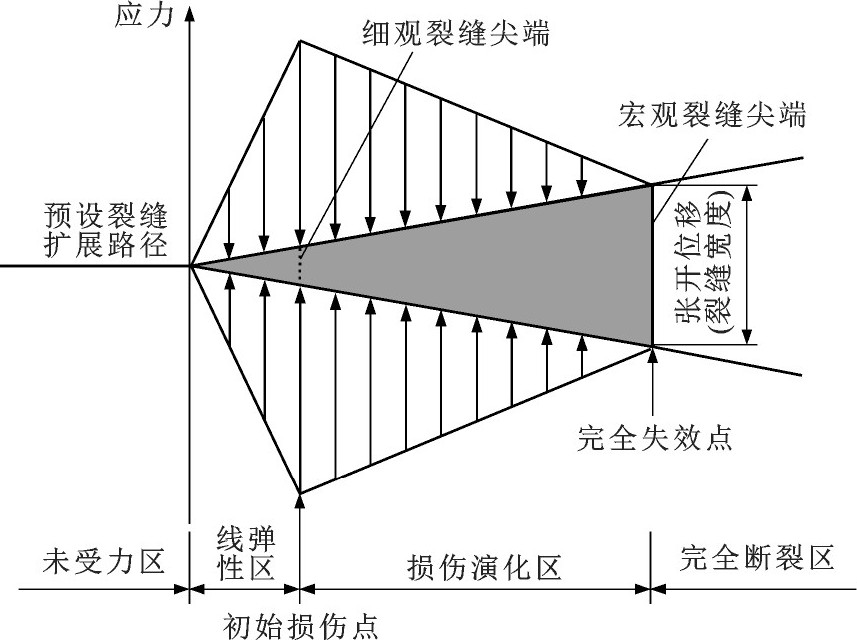Application of cohesive zone model to simulate reflective crack of asphalt pavement
-
摘要: 结合ABAQUS有限元软件, 分析了基于牵引力-分离法则的三维黏结单元本构模型与参数; 通过对单一黏结单元施加位移荷载, 对比了不同初始损伤与完全失效准则组合下, 加载过程中单元应力、位移和应变能的理论计算结果与数值模拟结果, 以验证黏结单元的可靠性; 将黏结单元布设在开裂基层上方沥青面层可能发生反射开裂的部位, 应用黏聚区模型模拟裂缝的发展过程, 研究了黏结单元参数和面层厚度对裂缝扩展的影响。分析结果表明: 当黏结层刚度由40GN·m-3下降到20GN·m-3时, 单侧荷载与对称荷载作用下黏结层中分离位移的比值由1.52增大到13.52, 单侧荷载作用下黏结层中剪切位移与张开位移的比值由1.52增大到11.32, 说明当潜在裂缝扩展区刚度降低时, 沥青层易于产生Ⅱ型剪切裂缝; 在交通荷载作用下, 沥青面层损伤开裂的路径为首先沥青面层底部发生损伤并向上发展, 随后路表轮载作用处附近发生损伤并向下发展, 在损伤贯穿沥青面层后, 潜在裂缝扩展区刚度的继续下降将使损伤沿道路横向继续扩展; 在面层厚度以2cm的梯度由16cm增加到22cm的过程中, 黏结层中分离位移分别降低了32.31%、15.22%、9.63%, 剪切位移与张开位移的比值由3.24降低到1.10, 说明增加面层厚度能有效延缓反射裂缝的扩展, 但此延缓效果随着面层厚度的增加而减弱, 并且使得面层反射开裂类型由Ⅱ型剪切型开裂逐渐趋于Ⅰ、Ⅱ型混合模式开裂。Abstract: Based on ABAQUS, the constitutive model and parameters of 3 Dcohesive element were analyzed by using the traction-separation law. By applying the displacement load on a cohesive element, the results of numerical simulation and theoretical computation of the stresses, displacements and strain energies were compared to verify the reliability of cohesive element under various combination rules of initial damage and complete failure in the loading process. In the asphalt surface course on the cracked base course, the cohesive elements were laid at the positions where reflective cracks might occur, the cohesive zone model was employed to simulatethe cracking procedure, and the effects of the parameters of cohesive element and the thickness of asphalt surface course on the crack propagation were studied. Analysis result shows that when the cohesive layer stiffness decreases from 40 to 20 GN · m-3, the ratio of separation displacements of cohesive layer under unilateral and symmetric loads increases from 1.52 to 13.52, and the ratio of shear displacement to normal displacement of cohesive layer increases from 1.52 to 11.32 under unilateral load, which indicates that the asphalt surface course tends to appear type-Ⅱ shear cracks as the stiffness of potential cracking area decreases. Under traffic load, the cracking path of asphalt pavement is as follows: first, the damage begins at the bottom of asphalt surface course and propagates upwards; next, other damages occur near the loading area and propagate downwards; finally, after penetrating the entire surface course, the continuous decrease of potential fracture zone's stiffness will cause crack to propagate along the transverse direction of the pavement. In the increasing process of surface course thickness from 16 to 22 cm with a 2 cm-gradient, the separation displacement of cohesive layer decreases by 32.31%, 15.22% and 9.63%, respectively, and the ratio of shear displacement to normal displacement decreases from 3.24 to 1.10, which indicates that the increase of surface course thickness can effectively mitigate the propagation of reflective crack, although the effect decreases as the thickness increases. Furthermore, the increase of surface course thickness makes the reflective crack gradually transfer from type-Ⅱshear crack to type-Ⅰ-Ⅱmixed crack.
-
表 1 单元验证组合准则
Table 1. Combination rules for element verification

表 2 单元初始损伤时的应力与位移理论值
Table 2. Theoretical values of stresses and displacements at element initiatial damage

表 3 单元完全失效时的位移与能量理论值
Table 3. Theoretical values of displacements and energies at element failure

-
[1] 陈贵锋. 高等级公路沥青路面反射裂缝的分析与防治[J]. 重庆交通学院学报, 2003, 22 (3): 33-36. doi: 10.3969/j.issn.1674-0696.2003.03.009CHEN Gui-feng. The analysis and prevention of reflective cracking in asphalt pavement of expressway[J]. Journal of Chongqing Jiaotong University, 2003, 22 (3): 33-36. (in Chinese). doi: 10.3969/j.issn.1674-0696.2003.03.009 [2] 李自林, 龚能飞, 栾小兵. 半刚性基层沥青路面温缩型反射裂缝的扩展机理分析[J]. 公路交通科技, 2008, 25 (1): 43-46, 63. doi: 10.3969/j.issn.1002-0268.2008.01.008LI Zi-lin, GONG Neng-fei, LUAN Xiao-bing. Development mechanism analysis of temperature shrinkage type reflective crack in asphalt pavement on semi-rigid base[J]. Journal of Highway and Transportation Research and Development, 2008, 25 (1): 43-46, 63. (in Chinese). doi: 10.3969/j.issn.1002-0268.2008.01.008 [3] 王金昌, 朱向荣. 面层与基层层间摩擦系数对应力强度因子影响的研究[J]. 岩石力学与工程学报, 2005, 24 (15): 2757-2764. doi: 10.3321/j.issn:1000-6915.2005.15.027WANG Jin-chang, ZHU Xiang-rong. Study on stress intensity factor affected by friction coefficient between surface layer and subbase[J]. Chinese Journal of Rock Mechanics and Engineering, 2005, 24 (15): 2757-2764. (in Chinese). doi: 10.3321/j.issn:1000-6915.2005.15.027 [4] 黄志义, 王金昌, 朱向荣. 含裂缝沥青混凝土路面的粘弹性断裂分析[J]. 中国公路学报, 2006, 19 (2): 18-23. doi: 10.3321/j.issn:1001-7372.2006.02.004HUANG Zhi-yi, WANG Jin-chang, ZHU Xiang-rong. Viscoelastic fracture analysis of asphalt concrete pavement with cracks[J]. China Journal of Highway and Transport, 2006, 19 (2): 18-23. (in Chinese). doi: 10.3321/j.issn:1001-7372.2006.02.004 [5] ELSEIFI M, AL-QADI I L. A simplified overlay design model against reflective cracking utilizing service life prediction[J]. Road Materials and Pavement Design, 2004, 5 (2): 169-191. doi: 10.1080/14680629.2004.9689968 [6] 金光来. 基于扩展有限元的沥青路面疲劳开裂行为的数值研究[D]. 南京: 东南大学, 2015.JIN Guang-lai. Numerical analysis of fatigue crack growth in asphalt pavement based on extended finite element model[D]. Nanjing: Southeast University, 2015. (in Chinese). [7] LING Jian-ming, TAO Ze-feng, QIAN Jin-song, et al. Investigation the influences of geotextile on reducing the thermal reflective cracking using XFEM[J]. International Journal of Pavement Engineering, 2018, 19 (5): 391-398. doi: 10.1080/10298436.2017.1402598 [8] ISLAM M R, VALLEJO M J, TAREFDER R A. Crack propagation in hot mix asphalt overlay using extended finiteelement model[J]. Journal of Materials in Civil Engineering, 2017, 29 (5): 04016296-1-14. doi: 10.1061/(ASCE)MT.1943-5533.0001815 [9] BARENBLATT G I. The formation of equilibrium cracks during brittle fracture. General ideas and hypotheses. Axiallysymmetric cracks[J]. Journal of Applied Mathematics and Mechanics, 1959, 23 (3): 434-444. [10] BARENBLATT G I. The mathematical theory of equilibrium cracks in brittle fracture[J]. Advances in Applied Mechanics, 1962, 7 (C): 55-129. [11] HILLERBORG A, MODER M, PETERSSON P E. Analysis of crack formation and crack growth in concrete by means of fracture mechanics and finite elements[J]. Cement and Concrete Research, 1976, 6 (6): 773-781. doi: 10.1016/0008-8846(76)90007-7 [12] XU X P, NEEDLEMAN A. Numerical simulations of fast crack growth in brittle solids[J]. Journal of the Mechanics and Physics of Solids, 1994, 42 (42): 1397-1434. [13] GEUBELLE P H, BAYLOR J S. Impact-induced delamination of composites: a 2D simulation[J]. Composites Part B: Engineering, 1998, 29 (5): 589-602. doi: 10.1016/S1359-8368(98)00013-4 [14] SONG S H, PAULINO G H, BUTTLAR W G. Simulation of crack propagation in asphalt concrete using an intrinsic cohesive zone model[J]. Journal of Engineering Mechanics, 2006, 132 (11): 1215-1223. doi: 10.1061/(ASCE)0733-9399(2006)132:11(1215) [15] SONG S H, PAULINO G H, BUTTLAR W G. A bilinear cohesive zone model tailored for fracture of asphalt concrete considering viscoelastic bulk material[J]. Engineering Fracture Mechanics, 2006, 73 (18): 2829-2848. doi: 10.1016/j.engfracmech.2006.04.030 [16] SOARES J B, DE FREITAS F A C, ALLEN D H. Considering material heterogeneity in crack modeling of asphaltic mixtures[J]. Transportation Research Record, 2003 (1832): 113-120. [17] MU F, VANDENBOSSCHE J. A superimposed cohesive zone model for investigating the fracture properties of concrete-asphalt interface debonding[J]. Fatigue and Fracture of Engineering Materials and Structures, 2017, 40 (4): 496-511. doi: 10.1111/ffe.12509 [18] 钮凯健, 李昶. 基于内聚力模型的沥青路面低温缩裂数值模拟[J]. 公路交通科技, 2012, 29 (6): 11-15, 21. doi: 10.3969/j.issn.1002-0268.2012.06.003NIU Kai-jian, LI Chang. Numerical simulation of low-temperature shrinkage cracking of asphalt pavement based on cohesive zone model[J]. Journal of Highway and Transportation Research and Development, 2012, 29 (6): 11-15, 21. (in Chinese). doi: 10.3969/j.issn.1002-0268.2012.06.003 [19] PARK K, PAULINO G H, ROESLER J R. A unified potential-based cohesive model of mixed-mode fracture[J]. Journal of the Mechanics and Physics of Solids, 2009, 57 (6): 891-908. doi: 10.1016/j.jmps.2008.10.003 [20] KIM Y R. Cohesive zone model to predict fracture in bituminous materials and asphaltic pavements: state-of-the-art review[J]. International Journal of Pavement Engineering, 2011, 12 (4): 343-356. doi: 10.1080/10298436.2011.575138 [21] 张东. 基于内聚力模型的沥青路面断裂研究[D]. 南京: 东南大学, 2010.ZHANG Dong. Research on fracture of asphalt pavements based on cohesive zone model[D]. Nanjing: Southeast University, 2010. (in Chinese). [22] KIM H, WAGONER M P, BUTTLAR W G. Simulation of fracture behavior in asphalt concrete using a heterogeneous cohesive zone discrete element model[J]. Journal of Materials in Civil Engineering, 2008, 20 (8): 552-563. doi: 10.1061/(ASCE)0899-1561(2008)20:8(552) [23] KIM H, WAGONER M P, BUTTLAR W G. Numerical fracture analysis on the specimen size dependency of asphalt concrete using a cohesive softening model[J]. Construction and Building Materials, 2009, 23 (5): 2112-2120. doi: 10.1016/j.conbuildmat.2008.08.014 [24] CAMANHO P P, DVILA C G, DE MOURA M F. Numerical simulation of mixed-mode progressive delamination in composite materials[J]. Journal of Composite Materials, 2003, 37 (16): 1415-1438. doi: 10.1177/0021998303034505 [25] 王宏畅. 半刚性基层沥青路面反射裂缝扩展及寿命研究[J]. 交通运输系统工程与信息, 2012, 12 (2): 174-180. doi: 10.3969/j.issn.1009-6744.2012.02.027WANG Hong-chang. Reflective crack propagation and fatigue life of semi-rigid base asphalt pavement[J]. Journal of Transportation Systems Engineering and Information Technology, 2012, 12 (2): 174-180. (in Chinese). doi: 10.3969/j.issn.1009-6744.2012.02.027 [26] 朱洪洲, 严恒, 唐伯明. 沥青混合料疲劳-蠕变交互作用损伤模型[J]. 中国公路学报, 2011, 24 (4): 15-20. https://www.cnki.com.cn/Article/CJFDTOTAL-ZGGL201104005.htmZHU Hong-zhou, YAN Heng, TANG Bo-ming. Damage model of interaction between fatigue and creep for asphalt mixture[J]. China Journal of Highway and Transport, 2011, 24 (4): 15-20. (in Chinese). https://www.cnki.com.cn/Article/CJFDTOTAL-ZGGL201104005.htm [27] 黄允江, 汪婧, 刘平, 等. 半刚性基层沥青路面反射裂缝处治新方法探讨[J]. 公路交通技术, 2016, 32 (4): 43-48. https://www.cnki.com.cn/Article/CJFDTOTAL-GLJT201604010.htmHUANG Yun-jiang, WANG Jing, LIU Ping, et al. Exploring new method to treat reflection crack on semi rigid base asphalt pavement[J]. Technology of Highway and Transport, 2016, 32 (4): 43-48. (in Chinese). https://www.cnki.com.cn/Article/CJFDTOTAL-GLJT201604010.htm [28] BAEK J, OZER H, WANG Hao, et al. Effects of interface conditions on reflective cracking development in hot-mix asphalt overlays[J]. Road Materials and Pavement Design, 2010, 11 (2): 307-334. doi: 10.1080/14680629.2010.9690278 [29] KIM H, BUTTLAR W G. Finite element cohesive fracture modeling of airport pavements at low temperatures[J]. Cold Regions Science and Technology, 2009, 57 (2/3): 123-130. [30] 顾强康, 冷培义. 水泥混凝土道面上沥青加铺层反射裂缝试验研究[J]. 中国公路学报, 1999, 12 (1): 21-27. doi: 10.3321/j.issn:1001-7372.1999.01.004GU Qiang-kang, LENG Pei-yi. Experimental research on reflection cracking of bituminous overlay on old concrete pavement[J]. China Journal of Highway and Transport, 1999, 12 (1): 21-27. (in Chinese). doi: 10.3321/j.issn:1001-7372.1999.01.004 [31] 周富杰, 孙立军. 复合路面沥青面层最佳厚度[J]. 同济大学学报, 2001, 29 (10): 1234-1239. doi: 10.3321/j.issn:0253-374X.2001.10.020ZHOU Fu-jie, SUN Li-jun. Optimal thickness of asphalt overlay on existing concrete pavement[J]. Journal of Tongji University, 2001, 29 (10): 1234-1239. (in Chinese). doi: 10.3321/j.issn:0253-374X.2001.10.020 [32] WANG Si-qi, HUANG Xiao-ming, MA Tao, et al. Numerical analysis of reflective cracking and fatigue lives of semi-rigid pavement structure using ABAQUS and FE-SAFE[J]. Journal of Southeast University: English Edition, 2015, 31 (4): 541-546. -





 下载:
下载:




















